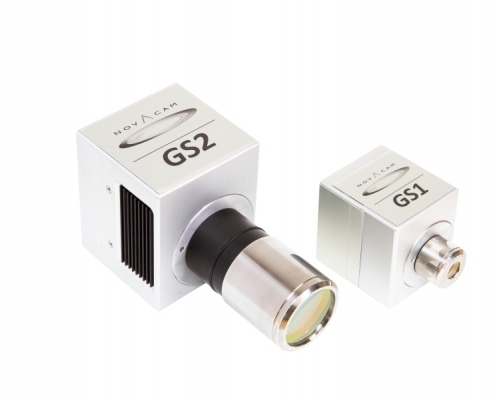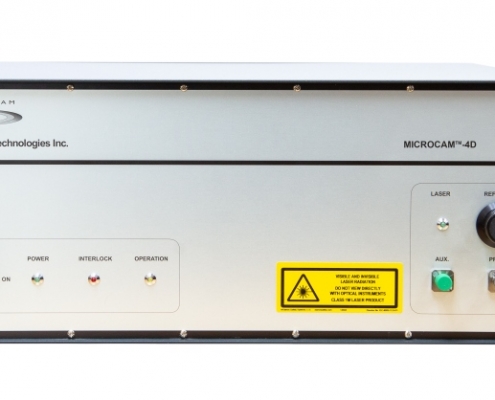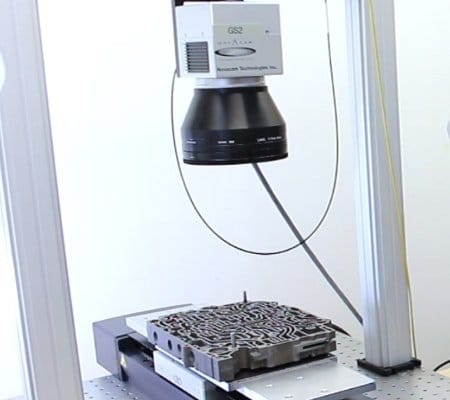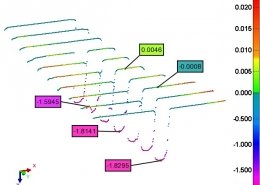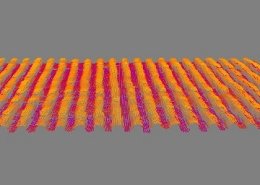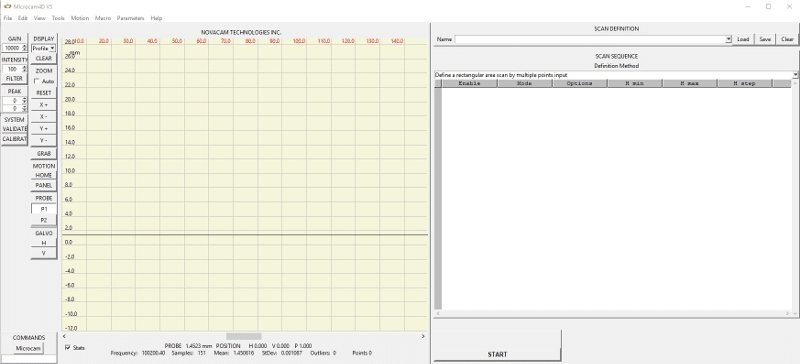SURFACEINSPECTTM system
for high-precision 3D metrology
NOVACAMTM SURFACEINSPECTTM system is a modular, non-contact 3D metrology system that:
- Acquires micron-resolution measurements of surfaces made of: metal, plastic, glass, ceramic, silicon, polymers, adhesive, composites, liquids, biological tissues, etc.
- Enables fully configurable automated inspection
- Supports user-defined specifications for geometric dimensioning and tolerancing (GD&T), roughness, waviness, etc.
- Supports detection of defects such as burrs, scratches, porosities, etc.
- Measures thickness of semi-transparent materials, including polymers and biological samples/tissue.
The SURFACEINSPECT system galvo scanner acquires surfaces in a raster fashion. Standard fields of view (FOV) go up to 85 x 85 mm. Larger samples are acquired by displacing the galvo scanner and/or samples using linear stages.
Automated flatness measurement
In this video, the SURFACEINSPECTTMsystem galvo scanner measures a valve body on a linear stage following a user-defined scanning sequence. Both automated reporting and interactive surface investigation are available with this system.
Overview of features and benefits
Measurements
- Optical, non-contact, non-destructive
- High speed: Up to 100,000 3D point measurements per second
- 2D and 3D topography of surfaces, including surfaces with high-aspect-ratio features
- Micron-precision axial resolution and excellent sensitivity and measurement repeatability
- Volume loss calculation, wear analysis
Imaging options
- Surface profiles
- Cross-sections (B-scans, C-scans) of semi-transparent materials (infrared-transparent materials)
- Height and light intensity images
- Deviation maps
- Volumetric images
Benefits
- Easily integrated in lab, shop, or fully-automated industrial inspection setups
Modular and customizable to your criteria - Reduces inspection cycle time: the non-contact optical scanner (or probe, depending on the setup) obtains up to 100,000 measurements per second. Each measurement represents a 3D topographic point.
- Flexible options for evaluating inspected parts: measured features can be compared to CAD drawings or to a set of user-defined GD&T callouts
- Simple scan definition and execution: The scanning sequence is defined once by teaching the system with a joystick. The scanning sequence can later be executed with the push of a button.
- Time-saving automated reporting: Following a scan, go-no-go reports can be produced and results logged in industry-standard formats
- Adaptable to harsh environments
- No consumables are needed: The optical galvo scanner does not come in contact with the measured surface, and therefore does not wear out like contact probes.
Metrology Applications
3D metrology and imaging of bores for industry and R&D
- Quality control
- Automated 3D production inspection, geometric dimensioning and tolerancing (GD&T)
- Statistical process control (SPC)
- Research and development (R&D) inspection
- Reverse engineering and part-to-CAD
- Maintenance, repair and operations (MRO)
- Profilometry in harsh environments
Typical measurements
- Full geometry
- GD&T parameters such as: position, profile, straightness, flatness, waviness, etc.
- Roughness: linear or area roughness
- Deviation from CAD model
- High-aspect-ratio features: teeth, undercuts, steps, grooves, splines, threads, channels, sharp edges
- Volume loss: surface wear or other damage
- Defect detection and characterization: corrosion, pitting, cracking, denting, scratching, porosity
- Thickness of semi-transparent coating, polymers and biological samples: single-layer or multilayer films
Examples of inspection applications
The SURFACEINSPECT system delivers 3D metrology across multiple industries – both in high-volume production and in research labs. A few examples of applications:
- Dimensions and surface finish of parts made by machining, casting, injection molding, 3D printing, additive manufacturing, welding, brazing, soldering
- Dimensions and thickness of extruded materials – plastics, ceramics, glass – during or after extrusion. Tubing, sheeting, fibres, etc.
- Continuous casting
- Tool maintenance, edge inspection – sharp edges, chamfered edges, bevel edges, filleted edges, miter edges, burr detection
- Protective film thickness in aviation and automotive industries, on consumer products
- Multilayer thickness measurements in the cellphone industry
- Optical: etching and deposition thickness on waveguides
- Semi-conductors: coating on MEMS devices, hybrid circuits, fuel and solar cells; wafer topography, thickness, flatness, defect detection; inspection of thick film photo-resist coating on electronic wafers
- Ophthalmology: inspection of regular or intraocular contact lenses
- Bio-medical: tissue thickness; GD&T and surface finish of orthopedic, ocular, dental, and hearing aid implants; coatings that protect devices from corrosion or patients from complications
- Metallurgy: forging, metal deposition in vacuum deposition chambers
- Others: conformal coating, protective tool coating, vacuum chamber coating
System Software
The SURFACEINSPECT system comes with NOVACAM high-performance data acquisition software, which is PC Windows®-based and user-friendly for scan programming.
The system simultaneously generates 3 data sets from the same scan: 3D point cloud, light intensity image, and height image. The height and light intensity images facilitate defect detection. STL file format is also available.
For full GD&T analysis of measured parts, a turnkey solution is available with PolyWorks InspectorTM metrology software that may be purchased with the system.
- Go-no-go reporting is easily programmed and automated.
- Users benefit from capabilities such as a quick visual comparison (deviation map) of the acquired part measurements to pre-specified tolerances or to the CAD of the part.
Visualizing the scan data may be accomplished by importing the data into various third party visualization and numerical analysis software, such as PolyWorks Inspector, Geomagic, ImageJ, SolidWorks, Octave, MatLab, Mathematica, IDL, or IGOR Pro.
Deriving application-specific measurements from the 3D point cloud is available through a selection of in-house and third party software. Novacam supports the following options:
| Novacam in-house software | 3rd party software, such as | |
|---|---|---|
| Dimensional measurements (GD&T parameters) | PolyWorks Inspector (turnkey solution) Geomagic |
|
| Roughness and surface analysis | TrueSurf, MountainsMap | |
| Thickness | ||
| Chatter (vibration) | ||
| Volume loss | ||
| Defects | Custom-developed* | |
| * Novacam offers the option of custom data processing, reporting, and defect detection programs that can be written based on client requirements. | ||
An application programming interface (API) is available for system integrators and OEMs to accommodate a wide variety of online and offline applications. Exported results may be integrated with data loggers and SPC software.
NOVACAMTM SURFACEINSPECTTM system is a fiber-based modular system that comprises 1) Galvo (raster) scanner, 2) MOCROCAMTM interferometer, 3) Inspection station, 4) PC, 5) Galvo controller and motion controllers(s) (not shown) and 6) Multiplexing hardware (optional, not shown).

galvo (raster) scanner
MICROCAM interferometer
Inspection Station
PC
The inspection capabilities of the SURFACEINSPECT system are determined jointly by its components:
1) Galvo scanner (GS)
The galvo scanner consists of a galvo head and a lens selected for the application. It acquires 3D surfaces or material thickness in an efficient raster pattern. The GS housing is robust and shop-floor ready.
Standard GS lens characteristics*
| Field of view (mm) | Standoff distance (mm) |
|---|---|
| 4.7 x 4.7 | 7.5 |
| 9.4 x 9.4 | 25.1 |
| 14.1 x 14.1 | 42.3 |
| 18.8 x 18.8 | 64 |
| 28.9 x 28.9 | 93.8 |
| 30 x 30 | 87.5 |
| 43 x 43 | 137 |
| 54 x 54 | 126 |
| 84 x 84 | 215.4 |
| *Only standard galvo scanner characteristics are listed in this table. Non-standard specifications are custom-built upon request. | |
2) MICROCAM interferometer
The MICROCAM interferometer provides the light source to the galvo scanner and processes the optical signal received from the scanner. The GS and the interferometer are connected with an optical fiber.
MICROCAM interferometer models
| MICROCAM-3D | MICROCAM-4D | |||
|---|---|---|---|---|
| General characteristics | ||||
| Technology | low-coherence interferometry | |||
| Light wavelength | 1310 nm, infrared | |||
| Size of interferometer enclosure box (depth x width x height) | 4U rackable enclosure 445 x 445 x 178 mm |
|||
| Non-contact measurements | ||||
| Depth of field | depends on the characteristics of the selected scanner (see table above) | |||
| Scanning depth range options* | 3.5 mm | 7 mm | 5 mm | |
| Acquisition (A-scan) rate | 2.10 kHz | 1.05 kHz | 100 kHz | |
| Axial (Z-axis) resolution | < 0.5 µm | |||
| Light spot size (Lateral [XY-axis] resolution) | 4.1 - 146 µm, depends on selected scanner characteristics. | |||
| Standoff distance | 1 - 100 mm for standard probes up to 1 m for non-standard probes |
|||
| Repeatability | < 1 µm | |||
| Thickness measurements | ||||
| Thickness measurement range (in Air, IR = 1.0) | 10 µm - 3.5 mm | 10 µm - 7 mm | 20 µm - 5 mm | |
| Typical materials for thickness measurements | glass, polymers, multi-layer films, coatings, plastics, silicone, liquids, specular or non-specular | |||
| Sample reflectivity | 0.1 - 100% | |||
| *To further increase maximum scanning depth, a mechanical displacement axis is available. | ||||
3) Inspection station
Inspection station configurations are application-dependent and can be supplied by Novacam. Fixturing for the part is not included.
Measurement may be carried out in 2 modes:
- Scanning in X direction only, where the scanned surface is moving relative to the lens in the Y direction
- Scanning in both X and Y direction to obtain an area at a time, with multiple scans stitched together if required.
For automated inline industrial inspection, NOVACAM galvo scanners may be integrated with precision stages or robots (as robot end-effectors) to support high-volume continuous flow manufacturing. They can also be integrated with third-party CMMs (coordinate-measuring machines) and CNC (computer numerical control) machines.
4) PC, monitor and joystick
The SURFACEINSPECT system comes with a PC (with NOVACAM acquisition software), a monitor, mouse, and joystick.
5) Galvo and motion controller(s)
The galvo controller and motion controller(s) are included. The galvo controller controls the motion of the light beam within the raster pattern. Depending on the number of additional motion axis required, the motion controllers are housed in a 2U, 3U, or 4U rackable enclosure.
6) Hardware for multiplexing support (optional)
With optional optical switches, more than one galvo scanner (possibly in combination with one or more optical probes) may be multiplexed to a single MICROCAM interferometer. Multiplexed galvo scanners and probes may be used one at a time. This option brings additional return on investment (ROI) to many installations.
Standard system configuration
A standard configuration of the SURFACEINSPECT system includes:
- Galvo scanner with a 30×30 mm field of view
- MICROCAM-4D profilometer
- PC with NOVACAM acquisition software
- 1 year warranty
Optional addition:
- 2-axis inspection station and 2-axis motion controller
Instrument safety
- MICROCAM systems feature an in-probe red laser pointer (650 nm wavelength) for alignment purposes.
- MICROCAM systems are Class 1M Laser products, with < 20 mW of infrared and < 5 mW of in-probe laser pointer.

Frequently asked questions
How long does it take to scan a surface with SURFACEINSPECT system?
- Scan time depends on the surface area and aspects you need to measure. The SURFACEINSPECT system features a galvo scanner which scans the surface in a raster fashion. The speed of the scan is user-programmable and the SURFACEINSPECT system acquires up to 100,000 measurements per second, or roughly 1 million 3D topography points in 10 seconds. The user selects the lateral sampling distance in X and Y directions and the size of the area to be scanned, which together determine the number of points that will be acquired and the time that the scan will take. In general, dimensional measurements (GD&T) require the least amount of points and can be achieved the fastest. Defect detection requires the most amount of points, of course depending on the size of defect you are looking for.
The following is an example of scanning-time calculation with acquisition speed of 100 kHz, i.e., 100,000 points per second (click table to enlarge).
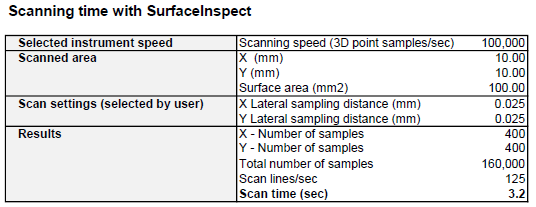
Example of a scanning speed calculation for a 10×10 mm area using SURFACEINSPECT system (100kHz)
For help on estimating the time required to scan your sample, please contact us.
Can the SURFACEINSPECT system measure parts that are not flat and high-aspect ratio features?
- Yes, depending on the geometry of the features to be scanned. Various curved surfaces and high-aspect ratio features have been scanned. Displacement stages can be added to the setup if required.
Can the SURFACEINSPECT system be used to measure the thickness of a coating?
- Yes, if the coating is semi-transparent to infrared light and has optical thickness of 20 µm or higher (optical thickness = physical thickness * index of refraction).
Is the system easy to use?
- Yes. The scanning sequence (recipe) can be programmed with a joystick and can be recalled at later times with the push of a button.
Is the system able to work right on production floor?
- Yes. The system is ideally suited for both lab and shop floor inspection. Inline and robot setups are also supported. The SURFACEINSPECT system can even be used to provide metrology in hostile environments such as extremely hot, cryogenic, or radioactive.
Can the SURFACEINSPECT system give us automated measurements and reports?
- Yes.
Does the light beam of the the SURFACEINSPECT system have to be perfectly perpendicular to the surface to be scanned?
- No. Some surfaces have been scanned with as much as 60 degrees between the light beam and the surface. The maximum scan angle depends on the material and surface characteristics.
Related links
Contact us or request free sample analysis to see if the SURFACEINSPECT system is suitable for your application.




